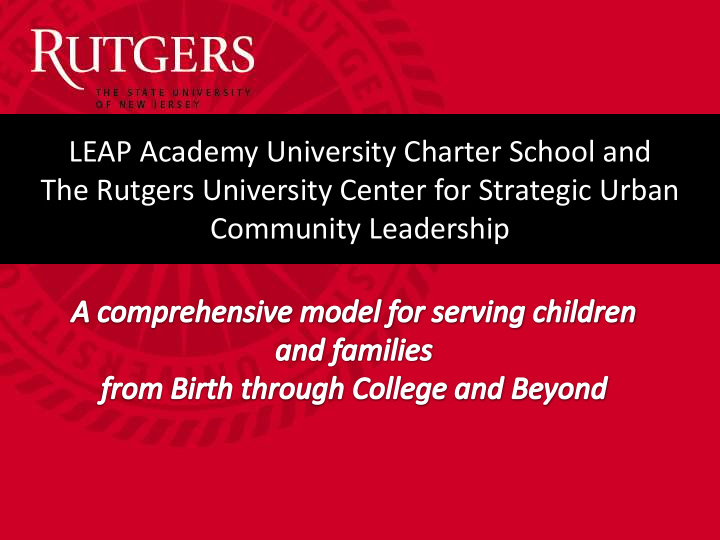



LEAP Academy University Charter School and The Rutgers University Center for Strategic Urban Community Leadership
Mission Statement The mission of the LEAP Academy is to enhance opportunities for the children and families of Camden through the collaborative design, implementation, and integration of education, health and human services, professional development, and community development .
Ten Essential Elements of The LEAP Model
Rigorous Performance Based Academic Compensation and Program from Entrepreneurial Professional PreK-College Governance/ Development Leadership Strong Family School Mission Engagement aligned to local Community Needs and Vision LEAP Partnerships Academy with Higher Education Charter Institutions and Schools Community Ongoing Stakeholders Assessment and Evaluation Comprehensive Health and Human Services STEM Focus Expanded Year Learning
Snapshots of the LEAP Academy • 840 students in grades K-12 served in two school buildings – Elementary Grades (K-6) – High School Grades (7-12) – STEM High School Program (9-12) • Rutgers-Camden Early Learning Research Academy • 12 infants (6 months - 1 year) • 20 toddlers (age 1-3 ) • 90 Preschoolers (age 3-4) 5
Rigorous Academic Program from Birth through College • Focus on college preparation for all students. • Emphasis on science, technology, mathematics and engineering. • Building educational pipelines from birth through college.
The Rutgers/LEAP Pipeline to College
Expanded Learning Time • 200 days of instruction • 7 hours and 50 minutes instructional day (8-4) • Extended Day (21 st century) from 4-7 p.m. • Saturday Academies • Summer Program in July
Partnerships with Higher Education and Community Stakeholders • Rutgers University • Rowan University • Camden County College – Governance – Dual Credit Options – Resources such as tutoring, curriculum development and professional development – Development of Educational Corridor
Partnerships with Higher Education and Community Stakeholders • Cooper Medical Center and UMDNJ • School Based Health Center • Medical Inspector • Community Partners • Resources • Leveraging • Funding • Legitimacy and alignment of school mission with larger community
Core Elements of LEAP’s Family Engagement Framework Informed and Collective School Participation and Decision Making Civic Leadership Comprehensive School- Training , Capacity Building Based Services and and Personal Growth Support
LEAP Principles for Family Engagement Civic Leadership School Participation • Parents are • Parents are • Parents are trained to think encouraged • Parents are encouraged to about future to provide encouraged be introspective possibilities and leadership to consider about their own expectations, for for change what roles parenting . both their that is they can play children and beneficial to to improve themselves. the school the school Training and the and the Personal community. community. Growth
Comprehensive Health and Human Services Comprehensive Health Services Mental Health Legal Services and Counseling Services LEAP Families Parent Training Early Childhood and Adult Education Education
LEAP BUILDINGS Elementary Grades (PK-6): 639 Cooper Street High School Grades (7-12): 549 Cooper Street
Early Learning Research Academy
S.T.E.M. high school
High school graduation and College placement rate • 100% in 2005 • 100% in 2006 • 100% in 2007 • 100% in 2008 • 100% in 2009 • 100% in 2010 • 100% in 2011
LEAP Academy University Charter School • Plans for expansion include two additional campuses around the City – STEM High School – Cramer Hill K-8 School
The Context of Charter Schools in New Jersey
What is a Charter School? • Tuition-free public schools created by parents, educators, and community leaders — open to all students — that operate under a five-year contract, or 'charter.'
What is a Charter School? • Charter school students are required to take all state tests, and must comply with laws regarding health, safety, civil rights and special education.
What is a Charter School? • Charter schools are independent and do not answer to a local school district superintendent or board of education. Instead, each charter school is run by its own board of trustees, responsible for overseeing the school and ensuring its success.
What is a Charter School? • They are free to develop their own curriculum, choose staff, set educational goals, offer a longer school day and school year, and establish their own standards for student behavior.
What is a Charter School? • In return, a charter school must show within its five-year charter period that it has raised student achievement. Only if the school raises achievement will its charter be renewed. If the school fails, the charter school may lose its charter, which means it will have no license to operate and would close.
Why a charter school? • focus on results • are academically innovative • remain public schools • enhance educational choices for parents and students • allow for true decentralization
Why a charter school? • keep policy decisions on-site • receive and have full control over all state, federal and local funds generated by their student count • provide a market driven educational system
The University Vehicle for Engagement
Children Families & Community Youth Better outcomes for Better outcomes for Better outcomes children and youth families for the community Strong Early Childhood Programs Safe schools and neighborhoods Quality health services High Performing Schools Social service programs Business development Effective K-12 programs Crime prevention Adult learning opportunities and Job readiness training Higher high school graduation Local/community based rates Neighborhood based leadership development employment opportunities Successful transitions from high Better housing options and school to college/career support for residents Legal services Academic enrichment programs Community Building and Ownership Social, recreation and character building for children and youth Interagency Collaboration CAMDEN RESIDENTS
Recommend
More recommend